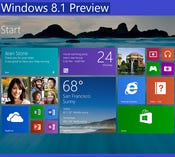Windows 8 Store Hits 100,000 AppsWindows 8 Store Hits 100,000 Apps
Microsoft reached the 100,000 apps mark much faster than its iOS and Android equivalents. But the milestone is still only a qualified victory.


10 Hidden Benefits of Windows 8.1
10 Hidden Benefits of Windows 8.1 (click image for larger view)
The Windows Store now includes more than 100,000 Modern-style apps for Windows 8 and Windows RT. Microsoft's marketplace crossed the six-figure threshold a little over eight months after launch -- much faster than Google and Apple's respective stores achieved the same volume.
The milestone might seem like a triumph for Microsoft. To an extent, it is. But the company was slow to embrace the mobile game, and much has changed in the meantime. While 100,000 apps is a victory, it's a qualified one.
Apple took more than a year to hit the century mark, and Android took even longer. But Microsoft allowed both platforms a big head start in the mobile space, and both capitalized. The iOS ecosystem boasts more than 850,000 apps, including more than 350,000 optimized for the iPad, and the Android universe is comparably huge. Windows 8 arguably has the most software leverage of any platform, with the ability to run not only the Modern titles but also legacy x86 applications. But that capability has produced only incremental improvements in market share.
Microsoft's achievement must be measured according to a new context, in other words. The world-beating standards to which prior Windows releases were held are much more difficult to sustain. There are too many options, and BYOD has given consumers much influence. The question isn't merely if Microsoft can catch up in the apps race but also how the company will respond to the millions of users who can't be tempted from competing ecosystems.
[ Looking for the best Win 8 budget apps? See 8 Free, Must-Have Windows 8 Apps. ]
On the topic of whether Windows 8 can catch up, its progress has been laudable but mixed. MetroStore Scanner, a site whose Windows Store tallies are often cited between official Microsoft statements, reports that after Windows 8 launched, app submissions dropped until February. Since then, activity has been on the rise. Microsoft has been offering $100 bonuses for new apps, and touting its revenue-sharing model, which pays up to 80% to the developer, as superior to competing opportunities. These efforts, as well as the steady stream of Windows 8.1 rumors, no doubt contributed to the renewed interest.
Last week, Microsoft used its Build developers conference to launch a preview version of Windows 8.1, an update with which the company hopes to address lingering unease about its Live Tiles interface. Unsurprisingly, June was also the Windows Store's best month to date, according to MetroStore Scanner, with around 640 new apps submitted daily.
But that progress is only part of the story.
When it comes to desktop dominance, Microsoft remains the undisputed champ; Windows versions cumulatively account for more than 91% of the market, and the Windows Store, the eventual destination for future desktop apps, trounces the Mac App Store for OS X.
But tablets are another matter. The number of Modern apps has risen, and Microsoft has secured some big-name partners, including Facebook. But the Windows Store still has an unfavorable quality-to-quantity ratio, and it still lacks major titles. True, 100,000 is a big number, but until more of the catalog attracts users, celebration is premature.
Even then, Android and iOS devices have cultivated committed user bases. People are using the tablets not only for recreation but also for work. Windows is still the most important OS in the enterprise, but If Microsoft doesn't extend some of its business software to its mobile competitors, it risks losing some of them to competing solutions.

8 Windows 8 Apps Under $25
8 Windows 8 Apps Under $25(click image for larger view and for slideshow)
The company has responded to this situation in several ways. This week, Microsoft rolled out a new version of OneNote for iOS and Android devices. Mac users are still stuck with the Web-based version, but Microsoft's willingness to play in competing ecosystems reveals a facet of the company's strategy -- namely, that iOS and Android can funnel users into Office 365, even if those users never consider using Windows 8.
Last week's release of a SkyDrive Pro app for iOS is another example, as is the company's promise, made this week, to release a mobile-oriented version of Dynamics CRM by this fall for both Windows 8 and the iPad.
On the other hand, Microsoft has also declined to release Office for the iPad, and its iOS version is only useful to those who also subscribe to Office 365. In the new landscape, the company must execute a complex strategy that alternates between defiantly proprietary and surprisingly open.
To a degree, the company has navigated this dilemma before; Microsoft Office is available for OS X, for example, but it's not as modern as the version available for Windows. Still, compared to past examples, Microsoft's new plan involves navigating a more complicated field.
Last week at Build, Microsoft added a few wrinkles to its "open" strategy. The company can still profit from iOS and Android apps, its representatives suggested, if Azure becomes the cloud infrastructure that supports them.
Microsoft also opened Bing as a development platform. At Build, Microsoft VP Gurdeep Singh Pall said the program can bring the "unbounded knowledge of the Web" to apps, and demonstrated examples that included apps integrated with 3-D maps as well as voice recognition, speech controls and language translation capabilities. Microsoft's APIs are mostly intended to help Microsoft developers make more engaging Windows 8 apps, but some attention is being extended on competing platforms as well -- another example of the tightrope the company is now traversing.
About the Author
You May Also Like






